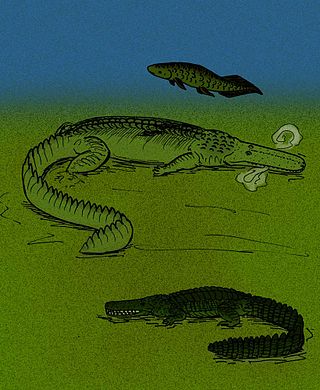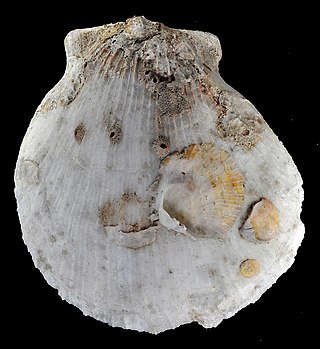
Sawfish, also known as carpenter sharks, are a family of rays characterized by a long, narrow, flattened rostrum, or nose extension, lined with sharp transverse teeth, arranged in a way that resembles a saw. They are among the largest fish with some species reaching lengths of about 7–7.6 m (23–25 ft). They are found worldwide in tropical and subtropical regions in coastal marine and brackish estuarine waters, as well as freshwater rivers and lakes. All species are endangered.

The largetooth sawfish is a species of sawfish in the family Pristidae. It is found worldwide in tropical and subtropical coastal regions, but also enters freshwater. It has declined drastically and is now critically endangered.

The smalltooth sawfish is a species of sawfish in the family Pristidae. It is found in shallow tropical and subtropical waters in coastal and estuarine parts of the Atlantic. Reports from elsewhere are now believed to be misidentifications of other species of sawfish. It is a critically endangered species that has disappeared from much of its historical range.

Carcharias is a genus of mackerel sharks belonging to the family Odontaspididae. Once bearing many prehistoric species, all have gone extinct with the exception of the critically endangered sand tiger shark.
Batrachosuchoides is an extinct genus of prehistoric amphibian from the Early Triassic of Russia. It was found in the Baskunchakskaia Series and the Lestanshorskaya Svita.

Retodus is an extinct genus of prehistoric lungfish found in Cretaceous-aged freshwater strata of Egypt, Algeria and Niger. The type species, R. tuberculatus, was named in 2006. It was originally named as a species of Ceratodus and Neoceratodus in 1963.

Pristis is a genus of sawfish of the family Pristidae. These large fish are found worldwide in tropical and subtropical regions in coastal marine waters, estuaries, and freshwater lakes and rivers. Sawfish have declined drastically and all species are considered critically endangered today.

Trachurus lathami is a species of fish in the family Carangidae and the genus Trachurus, the jack mackerels. Common names include rough scad and horse mackerel in English, as well as chinchard frappeur (French), chicharro garretón (Spanish), jurel, and carapau, garaçuma, surel, and xixarro. It is native to parts of the western Atlantic Ocean, including seas off the eastern coasts of North and South America and the Gulf of Mexico.

Crepipora is an extinct genus of marine bryozoans belonging to the Ceramoporidae family. There are currently 18 collections from Belarus, Sweden, Canada, France and the United States. It was first assigned to Cystoporata by Sepkoski in 2002. The fossil range is from the Middle Ordovician to the Upper Ordovician.

Pholadomya is a genus of saltwater clams, marine bivalve molluscs in the family Pholadomyidae.
The Piney Point Formation is a geologic formation in Virginia. It preserves fossils dating back to the Lutetian Stage of the Eocene Epoch of the Paleogene period.
Lavushi Manda National Park is a national park in the Muchinga Province of Zambia with an area of 1,500 sq km. It is the 11th largest of the 20 National Parks in Zambia. The park was initially gazetted as a Game Reserve in 1941, and was declared a National Park in 1972. It is located in Muchinga Province, in a district of the same name (Lavushimanda), with the South Luangwa National Park in the neighbouring Mpika District. It is adjacent to Bangweulu Game Management Area to the northwest, Kafinda Game Management Area lies further west. The chiefdom of Chiundaponde is in the northwest, north lies Luchembe, northwest Chikwanda, east Mpumba, and south lies Muchinka chiefdom. It covers a small range of mountains and hills, and is principally covered in miombo woodlands, with a number of rivers and streams, and a few areas of grassland, both on drier land or in the form of seasonally wet dambos. There are few large mammals, due to poaching in the previous century, but fishing and hiking are possible. Certain antelope species retreat upland to the park from the Bangweulu swamps to the northwest during the rainy season.

Leyvachelys is an extinct genus of turtles in the family Sandownidae from the Early Cretaceous of the present-day Altiplano Cundiboyacense, Eastern Ranges, Colombian Andes. The genus is known only from its type species, Leyvachelys cipadi, described in 2015 by Colombian paleontologist Edwin Cadena. Fossils of Leyvachelys have been found in the fossiliferous Paja Formation, close to Villa de Leyva, Boyacá, after which the genus is named. The holotype specimen is the oldest and most complete sandownid turtle found to date.
Pisco Basin is a sedimentary basin extending over 300 kilometres (190 mi) in southwestern Peru. The basin has a 2 kilometres (6,600 ft) thick sedimentary fill, which is about half the thickness of more northern foreland basins in Peru.
Pristis aquitanicus is an extinct species of sawfish in the family Pristidae. It lived in the Neogene period in France, Portugal, Florida, and India. It lived in marine, bays, and estuaries. It was a nektobenthic carnivore.
Myliobatis bothriodon is a species of extinct eagle ray that lived for 8.2 million years. It only has one occurrence, which was in Nigeria, during the Eocene epoch. The specimen was found in a Lutetian marine horizon.
Paracarinachites is a genus of sclerite-bearing creatures known from the early Cambrian period, originating around 530-520 Ma. They are often represented within the distinguished small shelly fauna (SSF) group because of their minuscule size-from only a few millimeters long, and because of their overt mineralized skeletons. Most SSF are from the clade Lophotrochozoa, however, it is unclear whether Paracarinachites are identified for certain as there have been rare cases of ecdysozoan SSF. Little is still known about the animal due to limited fossil collections; there are currently 27 known collections from China according to Fossilworks.

Sphodrosaurus is an extinct genus of basal archosauriformn reptiles from the Late Triassic-aged New Oxford Formation of Pennsylvania. The type species is S. pennsylvanicus, described by Edwin Colbert in 1960. The holotype consists of a partial skeleton including the back of the skull, the vertebral column, all of the ribs, all of the hindlimbs and part of the upper forelimbs; Sphodrosaurus was originally believed to have been a member of the Procolophonidae while more recently Sphodrosaurus was believed to be a basal member of the Diapsida by most authors starting with Sues et al. (1993), or a member of the Rhynchosauria. In 2022, Ezcurra & Sues redescribed the holotype in detail and placed it in a phylogenetic analysis with other Triassic diapsid reptiles, where it was found as the basalmost doswellid.
Pristis amblodon is an extinct species of sawfish within the family Pristidae. It currently has two occurrences originating from New Jersey in both the Eocene and Miocene epoch. It was a nektobenthic species that lived in marine waters.

Spondylus candidus is a species of bivalve mollusc within the family Spondylidae. Its distribution covers areas near coasts of Australia and South Africa, and in the Red Sea where it lives in benthic environments at depths of 21 to 75 meters. Fossil occurrences have been found in the Quaternary of Djibouti and in the Miocene of Japan and Vanuatu.











